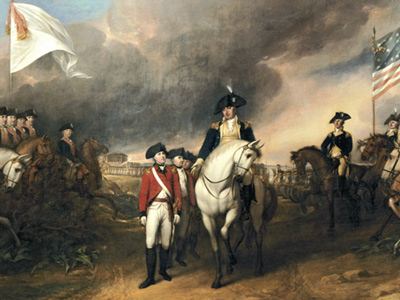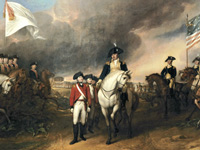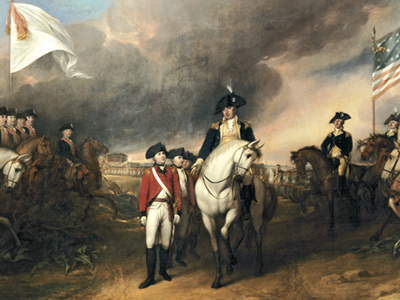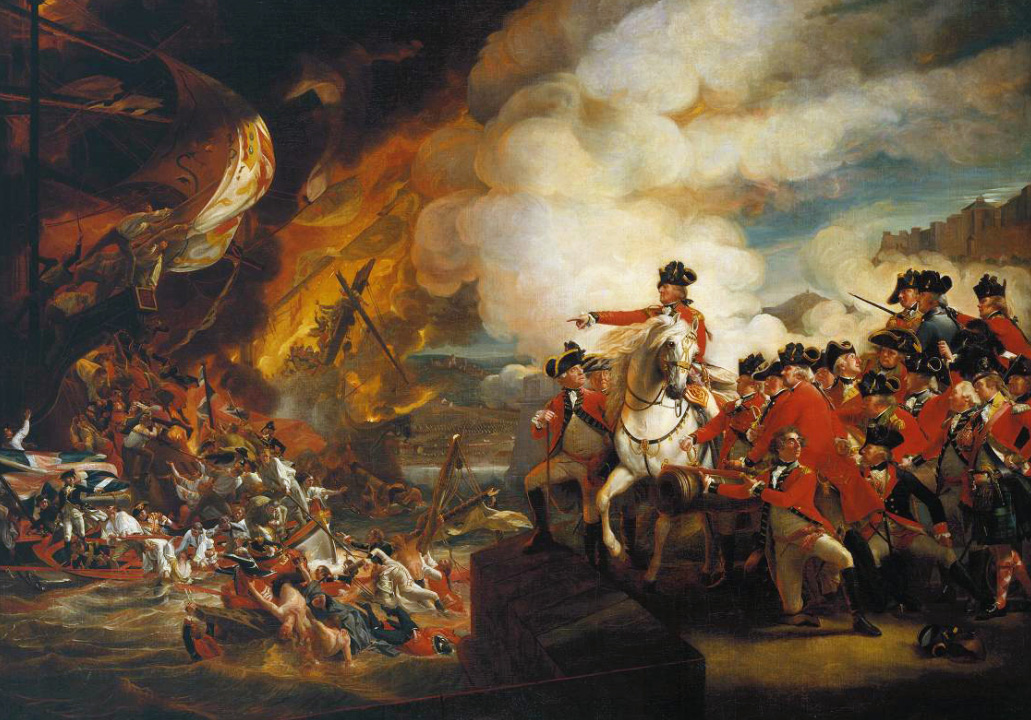American Revolutionary War (1775–1783)

International War Breaks Out (1778–1780)
Europe
Soon after France declared war, French and British fleets fought an indecisive action off Ushant on 27 July 1778. On 12 April 1779, Spain entered the war, with a primary goal of capturing Gibraltar. On June 24, Spanish troops under the Duc de Crillon laid siege to the Rock. The naval blockade, however, was relatively weak, and the British were able to resupply the garrison. Meanwhile, a plan was formulated for a combined Franco-Spanish invasion of the British mainland. A combination of poor planning, disease, logistical issues and high financial expenditures resulted in the expedition's failure. However, a diversionary Franco-American squadron under John Paul Jones did meet with some success on 23 September. On 16 January 1780, the Royal Navy under George Rodney scored a major victory over the Spanish The Spanish Empire was a colonial empire governed by Spain and its predecessor states between 1492 and 1976. One of the largest empires in history, it was the first to usher the European Age of Discovery and achieve a global scale, controlling vast territory. It was one of the most powerful empires of the early modern period, reaching its maximum extent in the 18th century., weakening the naval blockade of Gibraltar.
The Spanish Empire was a colonial empire governed by Spain and its predecessor states between 1492 and 1976. One of the largest empires in history, it was the first to usher the European Age of Discovery and achieve a global scale, controlling vast territory. It was one of the most powerful empires of the early modern period, reaching its maximum extent in the 18th century., weakening the naval blockade of Gibraltar.
On 9 August, a Franco-Spanish fleet commanded by Luis de Córdova intercepted and decisively defeated a large British convoy off The Azores, led by John Moutray, bound for the West Indies. The defeat was catastrophic for Britain The Kingdom of Great Britain was a sovereign country in Western Europe from 1 May 1707 to the end of 31 December 1800. The state was created by the 1706 Treaty of Union and ratified by the Acts of Union 1707, which united the kingdoms of England (which included Wales) and Scotland to form a single kingdom encompassing the whole island of Great Britain and its outlying islands, with the exception of the Isle of Man and the Channel Islands.; losing 52 merchant ships, 5 East Indiamen, 80,000 muskets, equipment for 40,000 troops, 294 guns and 3,144 men, making it one of the most complete naval captures ever made. The loss was valued at some £1.5 million, or £180 million in today's money, dealing a severe blow to British commerce.
The Kingdom of Great Britain was a sovereign country in Western Europe from 1 May 1707 to the end of 31 December 1800. The state was created by the 1706 Treaty of Union and ratified by the Acts of Union 1707, which united the kingdoms of England (which included Wales) and Scotland to form a single kingdom encompassing the whole island of Great Britain and its outlying islands, with the exception of the Isle of Man and the Channel Islands.; losing 52 merchant ships, 5 East Indiamen, 80,000 muskets, equipment for 40,000 troops, 294 guns and 3,144 men, making it one of the most complete naval captures ever made. The loss was valued at some £1.5 million, or £180 million in today's money, dealing a severe blow to British commerce.
Americas
In the Caribbean, intending to damage British trade, the French blockaded the lucrative sugar islands of Barbados and Jamaica. In order to improve communication among French Caribbean islands, and to strike a blow to privateering, French troops led by the Marquis de Bouillé captured Dominica on 7 September 1778. To monitor the French naval base on Martinique, the British defeated a French naval force on 15 December, and captured St. Lucia on 28 December. Though both fleets received reinforcements through the first half of 1779, the French under the Comte d'Estaing soon enjoyed superiority in the Caribbean, and began capturing British territories; seizing St. Vincent on 18 June, and Grenada on 4 July. On July 6, having pursued d'Estaing from Grenada, the British fleet under John Byron was tactically defeated, the worst loss the Royal Navy had suffered since 1690. Naval skirmishes continued until 17 April 1780, when British and French fleets clashed indecisively off Martinique.
On the mainland, Bernardo de Gálvez, governor of Louisiana, had intercepted intelligence the British were planning to invade New Orleans, and decided to strike first. Gálvez intended to conquer West Florida, and set out with 670 men on August 27, 1779, though his force was soon swollen to 1,400 by local Native Americans. On 7 September, Fort Bute fell to the Spanish, who then marched on to Baton Rouge, arriving on September 12. After a nine-day siege, the town fell. Leaving a garrison behind, Gálvez returned to New Orleans to recruit additional troops. In early 1780, Gálvez mounted an expedition to take Mobile, setting off with 750 troops on 11 January. Joined by reinforcements from Havana, siege operations commenced on March 1, and the town fell after a 14-day siege. Gálvez had hoped to push on to Pensacola, the British capital of West Florida, however, a hurricane devastated his expedition, stalling it till 1781.
In Central America, the defence of Guatemala was a priority for Spain. The British intended to capture the key fortress of San Fernando de Omoa and drive the Spanish from the region. After inadequate first attempts, 1,200 British troops led by William Dalrymple arrived on 16 October, and captured the fort on 20 October. However, the British suffered terribly due to disease, and were forced to abandon the fort on 29 November, and Spanish troops subsequently reoccupied the fort. In 1780, John Dalling, governor of Jamaica, planned an expedition to cut New Spain in two, by capturing Granada, which would subsequently allow them full control of the San Juan River. The British expedition, led by John Polson and Horatio Nelson, set out on 3 February 1780. On 17 March, the expedition reached Fort San Juan and laid siege, capturing it on 29 April. The British were ravaged by disease, and were running low on food due to poor logistics. The British withdrew on 8 November, the expedition having suffered a decisive defeat; some 2,500 troops had perished, making it the costliest British disaster of the war.
India
After word of hostilities with France The Kingdom of France is the historiographical name or umbrella term given to various political entities of France in the medieval and early modern period. It was one of the most powerful states in Europe since the High Middle Ages. It was also an early colonial power, with possessions around the world. Colonial conflicts with Great Britain led to the loss of much of its North American holdings by 1763. The Kingdom of France adopted a written constitution in 1791, but the Kingdom was abolished a year later and replaced with the First French Republic. reached India, the British East India Company moved quickly to capture French possessions, and took Pondicherry after a two-week siege on 19 October 1778. The Company resolved to drive the French out of India entirely, capturing the Malabar port of Mahé in 1779. Mahé had been under the protection of Mysore, as French ordnance passed through the port to the Mysorean ruler, Hyder Ali. Tensions were already inflamed due to British support for Malabar rebels against Ali, and the fall of Mahé precipitated war. In July 1780, Ali invaded the Carnatic, and laid siege to Tellicherry and Arcot. A 7,000-strong Company relief force under William Baille was intercepted and destroyed by the Tipu Sultan on 10 September; thus far the worst defeat suffered by a European army in India. Instead of pressing on for a decisive victory against a second Company army at Madras, Ali renewed the siege at Arcot, capturing it on 3 November. The delay allowed British forces to regroup for campaigning the following year.
The Kingdom of France is the historiographical name or umbrella term given to various political entities of France in the medieval and early modern period. It was one of the most powerful states in Europe since the High Middle Ages. It was also an early colonial power, with possessions around the world. Colonial conflicts with Great Britain led to the loss of much of its North American holdings by 1763. The Kingdom of France adopted a written constitution in 1791, but the Kingdom was abolished a year later and replaced with the First French Republic. reached India, the British East India Company moved quickly to capture French possessions, and took Pondicherry after a two-week siege on 19 October 1778. The Company resolved to drive the French out of India entirely, capturing the Malabar port of Mahé in 1779. Mahé had been under the protection of Mysore, as French ordnance passed through the port to the Mysorean ruler, Hyder Ali. Tensions were already inflamed due to British support for Malabar rebels against Ali, and the fall of Mahé precipitated war. In July 1780, Ali invaded the Carnatic, and laid siege to Tellicherry and Arcot. A 7,000-strong Company relief force under William Baille was intercepted and destroyed by the Tipu Sultan on 10 September; thus far the worst defeat suffered by a European army in India. Instead of pressing on for a decisive victory against a second Company army at Madras, Ali renewed the siege at Arcot, capturing it on 3 November. The delay allowed British forces to regroup for campaigning the following year.
HISTORY

RESOURCES
This article uses material from the Wikipedia article "American Revolutionary War (1775–1783)", which is released under the Creative Commons Attribution-Share-Alike License 3.0.
© Stories Preschool. All Rights Reserved.










